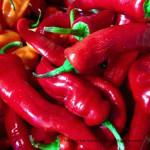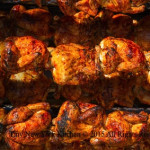Slow Cooking
If you have an old family recipe that you would like to make in the slow cooker, just follow these easy steps.
Cut the liquid required by a third to a half.
Brown meat first for extra color and flavor.
Add vegetables like onions, carrots, and squash at the beginning. Quicker cooking vegetables should be added later.
For a recipe that usually takes around an hour, cook for 4 hours on high or 8 hours on low.
No peeking! Because slow cookers can take awhile to reach optimum heat, it is important to keep them covered throughout the entire cooking period. Every time you lift the lid to check on progress, the cooker loses heat and it can take some time for it to get back up to the correct temperature.
“Work With What You Got!”
© Victoria Hart Glavin Tiny New York Kitchen © 2015 All Rights Reserved
Now that the weather has begun to get cooler it’s time for roasts. Standing rib roast is my all-time favorite minus the price tag.
So easy to make, too. Turn oven to roast at 350 degrees. Thyme and basil on top along with garlic and olive oil. Place uncovered in oven until it’s how you like to eat it. Remember to let it stand for a bit when removed from the oven as it will continue to cook while it’s resting.
“Work With What You Got!”
© Victoria Hart Glavin Tiny New York Kitchen © 2015 All Rights Reserved
Bell Pepper Basics
Bell peppers are also called sweet peppers. They are not hot in flavor and come in lots of colors. Bell peppers are an excellent source of vitamin C & B6.
Green: Most common and less sweet than others.
Red: Fully ripe green peppers turn red and are sweeter than green. Green bell peppers cost less and store longer than other types.
Yellow and Orange: Bright in color with a mildly sweet fruity flavor.
Purple, White or Brow: May be available from farmers’ markets or by growing your own.
Choose bell peppers that are firm and heavy for their size with bright coloring and glossy skin. If stems are still attached they should be firm and green.
Fresh peppers are more available and tastier while in-season during the summer and early fall.
Avoid peppers that have thin wrinkled skin or brown patches.
Buy only what you will use within a week or plan to freeze extras for future use.
Keep bell peppers fresh by washing just before serving.
Cutting bell pepper: After washing, cut off stems and cut peppers in half – lengthwise or crosswise. Remove seeds and the white membrane from the inside. Cut peppers into rings, strips or dice them into squares. Cut peppers can be stored, covered, for 2 days in the refrigerator.
Whole peppers can be stored in the refrigerator for up to 5 days. They are easy to freeze for longer storage. No blanching is needed. Place peppers in freezer bags or containers. Seal and label with the date. Frozen peppers should be used within 8 months.
“Work With What You Got!”
© Victoria Hart Glavin Tiny New York Kitchen © 2015 All Rights Reserved
Apples are available year-round with peak season September through November.
When choosing apples, look for firm apples, free from bruises or soft spots. Apples are sold ready for eating. Select variety according to intended use.
Refrigerate for up to 6 weeks. Store bulk apples in a cool, moist place.
“Work With What You Got!”
© Victoria Hart Glavin Tiny New York Kitchen © 2015 All Rights Reserved
Umami is considered the fifth flavor (after sweet, sour, salty, and bitter). Umami is difficult to define, but is “something” that makes a meal memorable. Often used by chefs, umami is a rich, savory taste imparted by the amino acid glutamate and ribonucleotides-molecules containing the sugar ribose that are components of RNA – that occur naturally in many foods. You can take your meals to the next level with ingredients rich in umami like anchovies, beef, fish sauce, miso paste, mushrooms, Parmesan cheese, or sun-dried tomatoes.
“Work With What You Got!”
© Victoria Hart Glavin Tiny New York Kitchen © 2015 All Rights Reserved
ROSH HASHANAH
SUNDAY EVENING, SEPTEMBER 13-15, 2015.
The Jewish New Year is nearly here, which is the beginning of the High Holy Days.
Rosh Hashanah meals typically include apples and honey, to symbolize a sweet new year. Other symbolic foods that may be served, depending on local custom, dates, pomegranates, black-eyed peas, pumpkin-filled pastries called rodanchas, leek fritters, beets, and a whole fish with the head intact. It is also common to eat stuffed vegetables called legumbres yaprakes.
If you’re cooking for Rosh Hashanah you may want to prepare these dishes to serve your family and friends.
Appetizers: Gefilte Fish Platter With Horseradish; Chopped Liver Platter; Potato Latkes; Sweet Potato Latkes
Soups: Matzo Ball Soup; Sweet Potato & Apple Soup; Chicken Soup
Entrées: Slow-Roasted Brisket With Gravy; Braised Short Ribs; Roasted Turkey Breast, Herb Roasted Chicken; Poached Chicken Breast With Dried Fruit; Salmon With Chickpeas, Peppers & Tomatoes; Poached Whole Salmon With Cucumber Dill Sauce
Sides: Potato Kugel; Green Beans With Shallots; Vegetable Tzimmes; Roasted Vegetables; Moroccan Quinoa; Garlic & Herb Roasted Beets; Rosemary Roasted Potatoes; Potato Latkes With Apple Sauce; Chunky Applesauce
Desserts: Honey Cake; Mini Tarts; Babka; Chocolate & Cinnamon Babka Slices; Rainbow Rugelach; Brownies; Seasonal Fresh Fruit; Apple Cake; Marble Cake; Apple Raisin Strudel
Happy New Year From Tiny New York Kitchen!
“Work With What You Got!”
© Victoria Hart Glavin Tiny New York Kitchen © 2015 All Rights Reserved
Ways To Use Your Roasted Chicken
Summer is over, the kids are back in school, and it’s back to busy life as usual. Already cooked chicken is a perfect way to save time in the kitchen. Here are some great ways to use roasted chicken for easy weeknight dinners.
Salads: Add to mixed greens, chopped tomatoes, chopped cucumbers, shredded carrots, and sliced red onions. Toss with your favorite low-fat or fat-free dressing.
Lettuce Wraps: Add 2 cups of chopped chicken to shredded carrots, green onions, and bean sprouts. Toss with teriyaki sauce. Spoon onto lettuce leaves and sprinkle with almonds. Fold sides of lettuce over filling and roll up.
Sandwiches & Wraps: Make a chicken salad filling with crunchy celery and apples. Use plain low-fat yogurt and add a touch of curry powder or cumin for dressing. Stuff into a pita pocket or spoon into a wrap and roll up.
Soups: Add 2 cups chopped chicken, your favorite chopped vegetables and 1 cup of uncooked rice or noodles to 6 cups of fat-free chicken broth.
Quesadillas: Combine shredded chicken with a pinch of cumin. Spoon on one half of a flour tortilla. Sprinkle with cheese and fold tortilla in half. Cook on a nonstick skillet for 3 minutes on both sides.
Burritos, Enchiladas, Fajitas & Tacos: Add shredded chicken to salsa, beans, sour cream and cheese. Or combine with sautéed onions & sweet peppers, shredded lettuce & chopped tomatoes, or mix with green chiles, spices, green onions and enchilada sauce. Serve on flour or corn tortillas.
Pasta Dishes: Use shredded chicken instead of ground beef in your favorite lasagna recipe.
Skillet Meals: Add 1 1/2 cups of chopped chicken to sautéed onions, broccoli, mushrooms, and rice. Cook in low-fat broth. Sprinkle on Parmesan cheese before serving.
“Work With What You Got!”
© Victoria Hart Glavin Tiny New York Kitchen © 2015 All Rights Reserved
5 Reasons To Love Coconut Oil
Coconut oil is an edible oil extracted from the kernel or meat of mature coconuts harvested from the coconut palm. Because of its high saturated fat content, it is slow to oxidize and is resistant to spoiling.
1. Butter Replacement. Coconut oil can replace butter, which is great for vegans, who up until now have had few good choices when converting non-vegan recipes that contain butter.
2. Great For Athletes. Coconut oil is great for athletes because it converts to energy faster than many other fats, making it a smart addition to workout snacks.
3. Weight Loss. Coconut oil may help you slim down. A study undertaken a few years ago suggests that coconut oil may help you lose weight, when consumed in small quantities instead of other fats.
4. Sautéing. Coconut oil is great for sautéing. Use coconut oil occasionally instead of olive oil to add a subtle flavor that is delicious in tropical or Indian recipes.
5. Good Cholesterol. Coconut oil boosts good cholesterol. While coconut oil is full of saturated fat, about half is medium-chain fatty acids, which seem to help raise HDL (good) cholesterol. Coconut oil is still high in fat, however, so consume in moderation.
“Work With What You Got!”
© Victoria Hart Glavin Tiny New York Kitchen © 2015 All Rights Reserved















